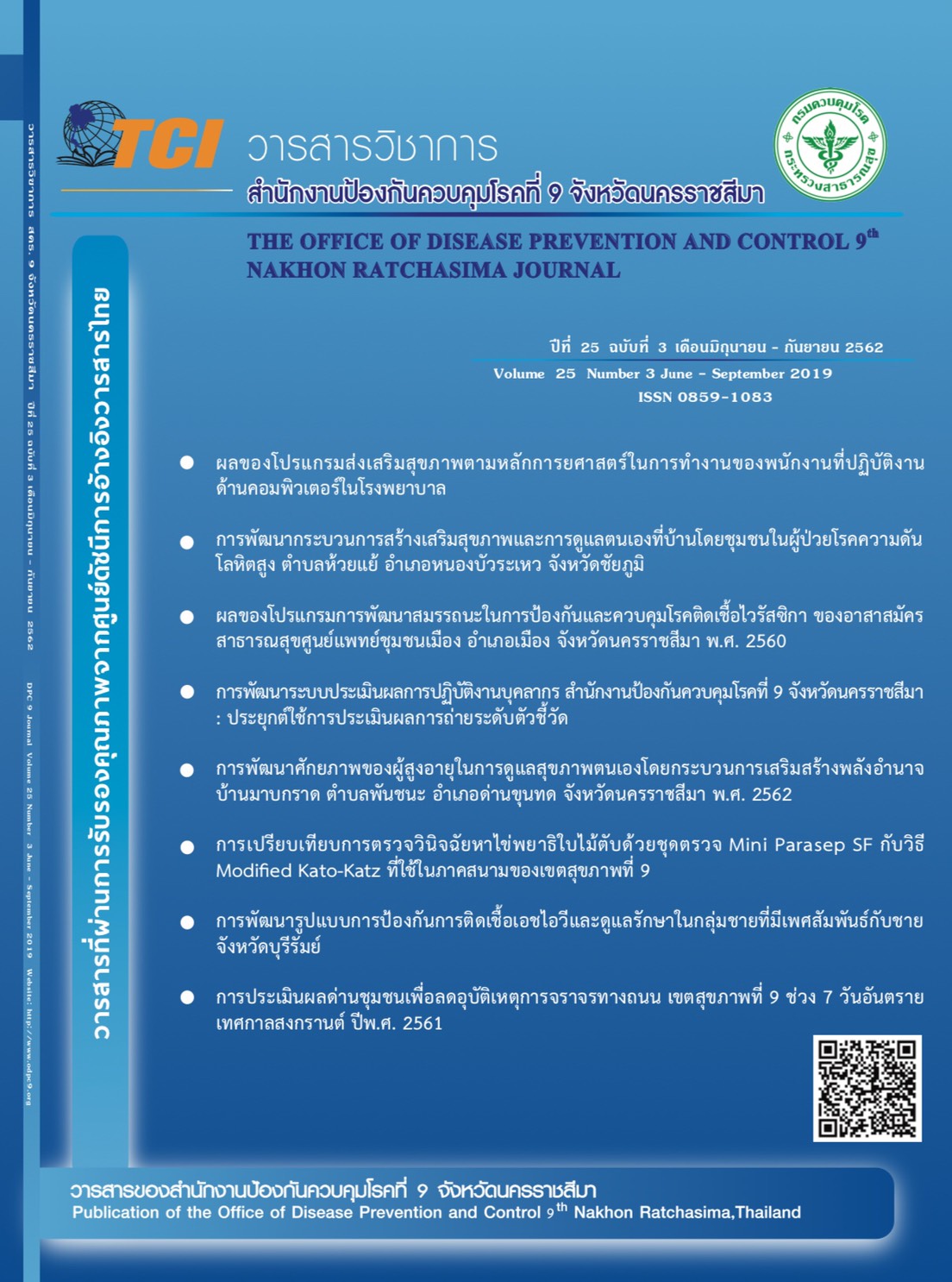Effects of Ergonomic Health Promotion Program on a Working Condition among Hospital Staffs Using Computers at Work
Keywords:
Health promotion program, Self – efficacy, Ergonomics, Neck pain releaseAbstract
Purpose of this quasi – experimental research was to study effects of ergonomic health promotion program in term
of a behavioral outcome and neck pain release. A total sample of 96 subjects was randomly selected by a systematic sampling.
There was equally divided into two groups. An experimental group was staffs of Suranaree University of Technology
Hospital (SUTH), received a 12-week of the program through the study. A control of staffs of Bangkok Ratchasima
Hospital did not receive the program. All subjects had completed a questionnaire including knowledge toward contents
of an ergonomic and neck pain condition, a perceived self-efficacy and an expected outcome on the promotion practice.
Neck pain release and disability index were also measured in this study. A descriptive statistic was used for describing the
characteristics and the outcome comparisons used paired t-test and independent t-test. Results of the study found that in
after the intervention, the experimental subjects had a significant mean score of the outcomes greater than a control group
about the knowledge, the perceived self-efficacy and the expected outcome (p<0.001). Scores of neck pain release and
disability index were significantly decreased than those a control group (p<0.001). The results indicate that this program
is effective on improving the outcomes in individuals who have an incorrect sitting posture and probably for neck pain
release.
References
การทำงานให้ถูกต้องตามหลักการยศาสตร์: กรณีศึกษาในบุคลากรสายสนับสนุนสำนักวิทยบริการมหาวิทยาลัย
ขอนแก่น,วารสารเทคนิคการแพทย์และกายภาพบำบัด 2553;22:167-178.
2. นํ้าฟ้า โคตรแก้ว และพรรณี บัญชรหัตถกิจ. ประสิทธิผลของโปรแกรมสุขศึกษาโดยการบูรณาการท่าทาง
การทางานตามหลักการยศาสตร์กับการรำไม้พลองในการปรับเปลี่ยนพฤติกรรมเพื่อลดอาการปวดหลัง
ส่วนล่างของคนงานกรีดยางพาราอำ เภอวังสะพุง จังหวัดเลย, วารสารวิจัยและพัฒนาระบบสุขภาพ
2556 ; 7(2) : 197-206.
3. พาวิณี ใจบาน, วีระพร ศุทธากรณ์ และ ธานี แก้วธรรมานุกูล. ปัจจัยด้านการยศาสตร์และอาการผิดปกติ
โครงร่างกล้ามเนื้อของบุคลากรสายสนับสนุนในโรงพยาบาลที่ทำงานกับคอมพิวเตอร์,วารสารพยาบาล
มหาวิทยาลัยเชียงใหม่ 2556 ; 40 : 1-11.
4. เพ็ญศิริ จันทร์แอ และ จุฬาภรณ์ โสตะ. ผลของโปรแกรมสุขศึกษาโดยการประยุกต์ใช้ทฤษฏีความสามารถตนเอง
ร่วมกับแรงสนับสนุนทางสังคมเพื่อปรับเปลี่ยนพฤติกรรมที่ส่งผลต่ออาการปวดหลังส่วนล่างด้วย
การออกกำลังกายท่าฤาษีดัดตนของบุคลากร มหาวิทยาลัยเทคโนโลยีราชมงคลอีสาน วิทยาเขตสกลนคร,
วารสารวิจัยและพัฒนาระบบสุขภาพ 2559 ; 8(3) : 244-249.
5. เมธินี ครุสันธิ์ และ สุนิสา ชายเกลี้ยง. ความชุก ความรู้สึกไม่สบายบริเวณ คอ ไหล่และหลังของพนักงานสำนักงาน
ของมหาวิทยาลัย ที่ใช้คอมพิวเตอร์แบบตั้งโต๊ะมากกว่า 4 ชั่วโมงต่อวัน, Graduate Research Conference
2014 : 1712-1722.
6. รัตนา มูลคำ , วีระพร ศุทธากรณ์ และนงค์คราญ วิเศษกุล. ผลของการออกกำ ลังกายแบบโยคะต่ออาการ
ปวดคอและไหล่ในพนักงานสำนักงานที่ทำงานกับคอมพิวเตอร์, พยาบาลสาร 2557; 41(3):70-82.
7. วิลาวัลย์ ชัยแก่น, ชวพรพรรณ จันทร์ประสิทธิ์ และธานี แก้วธรรมานุกูล. ปัจจัยด้านการยศาสตร์และอัตรา
ความชุกของอาการปวดทางโครงร่างและกล้ามเนื้อในคนงานโรงงานผลิตชิ้นส่วนสารกึ่งตัวนำ ใน
นิคมอุตสาหกรรมภาคเหนือ,วารสารวิชาการสาธารณสุข 2556 ; 16(2) : 226-233.
8. สำนักงานสถิติแห่งชาติ กระทรวงเทคโนโลยีสารสนเทศและการสื่อสาร. สรุปผลการสำรวจการใช้เทคโนโลยี
สารสนเทศและการสื่อสารในครัวเรือน พ.ศ. 2558. [Internet]. 2559 [เข้าถึงเมื่อ 13 พฤศจิกายน 2560].
เข้าถึงได้จาก http://service.nso.go.th/nso/nsopublish/themes/files/icthh59.pdf.
9. อรุณ จิรวัฒน์กุล. ชีวสถิติ, พิมพ์ครั้งที่ 3. ขอนแก่น : คลังนานาวิทยา, 2551.
10. Bandura, A. Self- efficacy the exercise control. New York : W.H. Freeman, 1997.
11. Chiung-Yu Cho, Yea-Shwu Hwang and Rong-JuCherng. Musculoskeletal Symptoms And Associated Risk
Factor Among Office Wokers With High Workload Computer Use. Journal of Manipulative and
Physiological Therapeutics 2012 ; 35(7) : 534-540.
12. Comerford, J. Ergonomics in the computer classroom 2003. [online]. 2015 [cited 2015 Oct 13].
Available : http://coe.sdsu.edu/eet/Articles/ergonomics/start.html.
13. KIM, K. Y. and KIM, M. G. Gender-related Factors Associated with Upper Extremity Function in Workers.
Safety Health Work 2010 ; 1 : 158-166.
14. Liyanage, E., Liyanage, I. and Khan, M. Efficacy of Isometric Neck exercises and stretching with
ergonomics over ergonomics alone in Computer Professionals. International Journal of Scientific and
Research Publications 2014 ;40(9) : 1-5.
15. Melzack, R., & Katz, J. Pain assessment in adult patients. In McMahon S.B. &
Koltzenburg M. (Eds). Wall and Melzack Textbook of Pain. 5th ed. Elsevier Churchill Livingstone,
2006 : pp. 291–304.
16. Widanarko, B. and other. Prevalence of musculoskeletal symptoms in relation to gender, age,
and occupational/industrial group. International Journal of Industrial Ergonomics 2011 ; 41 : 561-572.
17. Uthaikhup, S., Paungmali, A. and Pirunsan, U. Validation of Thai versions of the Neck Disability Index
and Neck Pain and Disability Scale in patients with neck pain. Spine 2011 ; 36(21) : 1415-1421.

Downloads
Published
How to Cite
Issue
Section
License
บทความที่ลงพิมพ์ในวารสารวิชาการสำนักงานป้องกันควบคุมโรคที่ 9 จังหวัดนครราชสีมา ถือว่าเป็น
ลิขสิทธิ์ สำนักงานป้องกันควบคุมโรคที่ 9 จังหวัดนครราชสีมา



